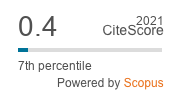Evaluation of entomopathogenic fungi Metarhizium anisopliae against dengue virus mosquitoes Aedes aegypti (Diptera: Culicidae)
Abstract
In this study, the bio-potential of the entomopathogenic fungus Metarhizium anisopliae was tested against Aedes aegypti under laboratory conditions. The study includes the analysis of the attractive response, survival and fecundity rate of non-blood and blood fed female mosquitoes exposed to the volatiles of two M. anisopliae strains. The attractive response was analysed using a two-choice behavioural bioassay, with three different sizes of dry spore plates (full, 1/4 and 1/16 plates). The survival and fecundity bioassay was conducted simultaneously in plastic pots. Log-rank survival curve analysis was used for statistical comparisons of the attractive response, survival and fecundity. Non-blood and blood fed mosquitoes were highly attracted to M. anisopliae-30 volatiles compared with that of the M. anisopliae-131 strain. Moreover, attraction was dependent on the size of the dry spore plate. Survival was completely abolished in unfed mosquitoes 5 and 6 days after treatment with 109 spores/mL of M. anisopliae-30 and M. anisopliae -131, respectively, whereas almost 80% of untreated unfed females survived more than 28 days. Survival in blood fed mosquitoes treated with same dose of M. anisopliae-30 and M. anisopliae-131was abolished after 6 and 7 days, respectively, while over 80% of untreated blood fed females survived more than 28 days in the controls. Mean number of eggs laid by blood fed mosquitoes treated with 109 spores/mL of M.anisopliae-131 was 26 ± 3 compared to control (67 ± 4). However for M. anisopliae-30, 19 ± 3 eggs were laid compared to control 72 ± 5 eggs. This study concludes that both the strains of M. anisopliae reduce egg laying capacity and survival rate in Ae. aegypti. As such, these strains can be useful for the development of mycoinsecticides for the control of the dengue fever vector mosquito, Ae. aegypti.


